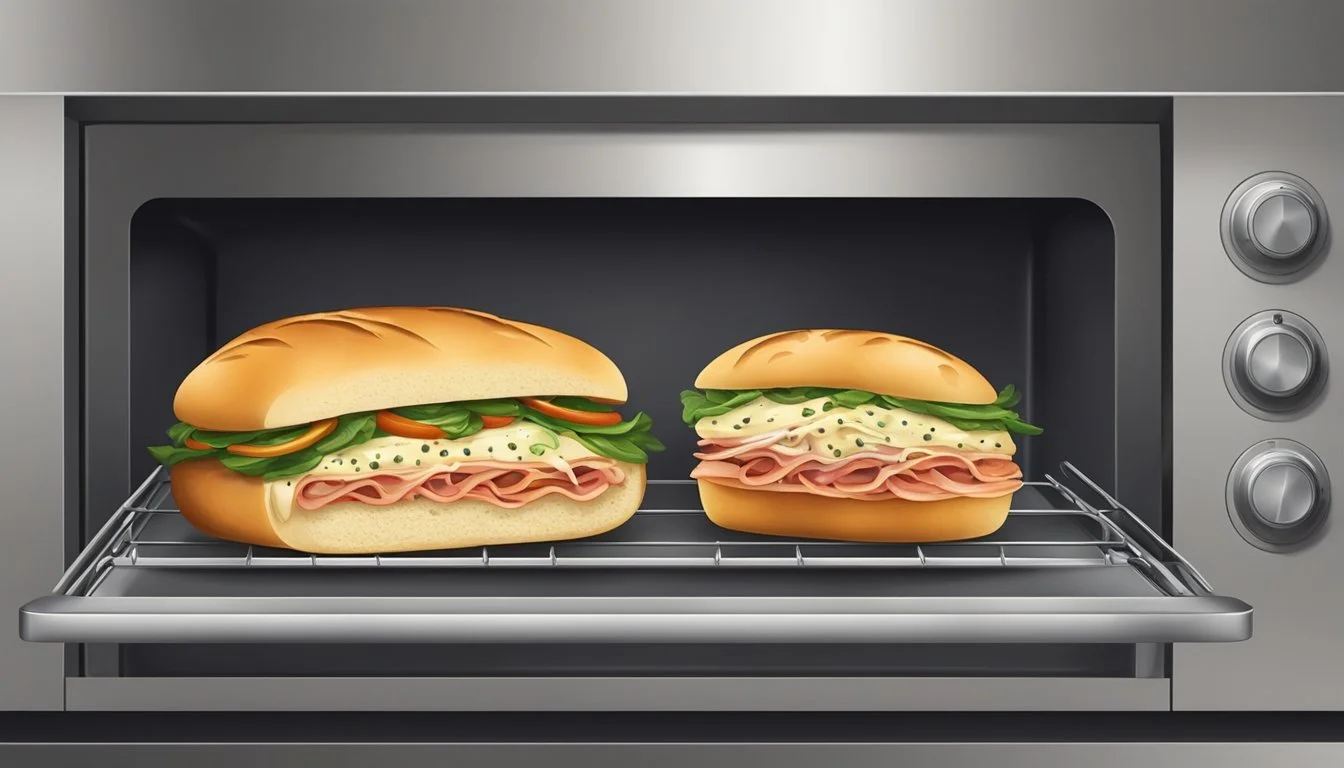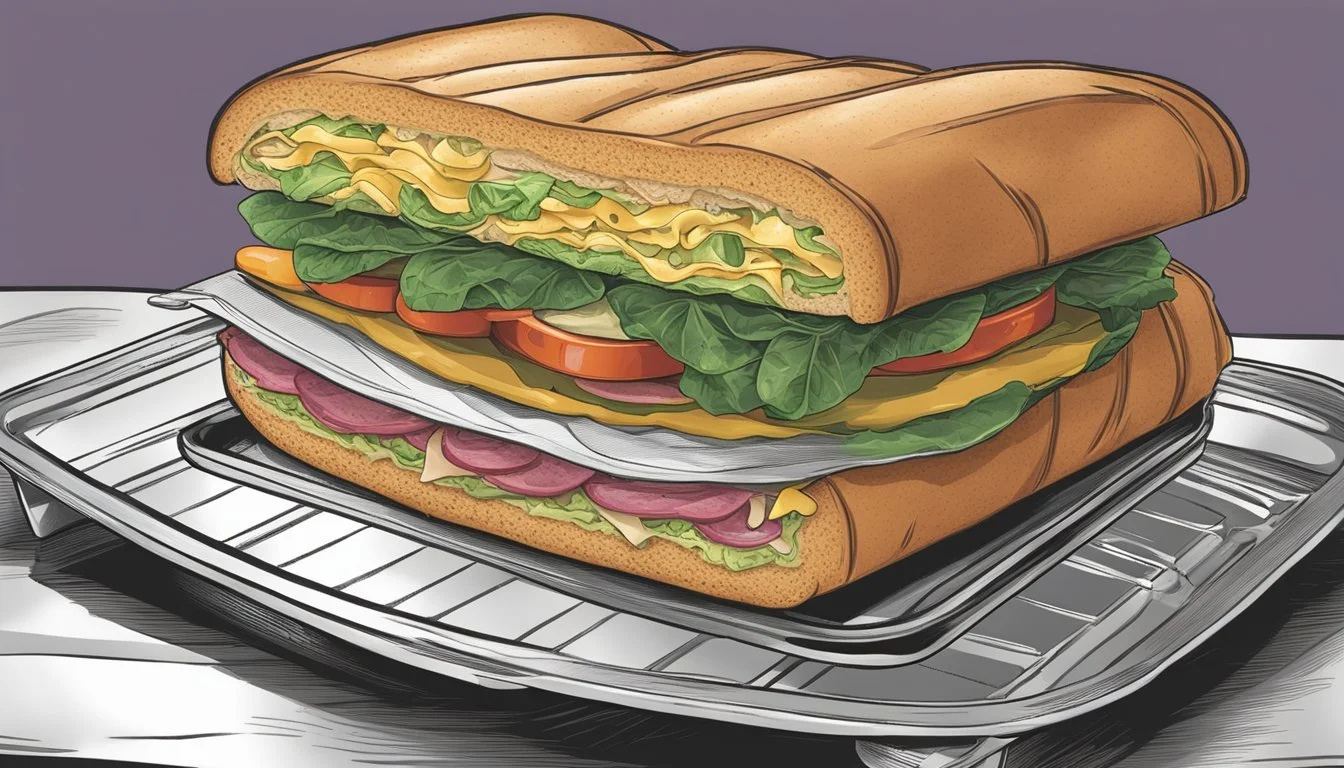Best Way to Reheat a Muffuletta
Ensuring Fresh Olive Salad Quality
A Muffuletta is more than just a sandwich; it is a New Orleans culinary icon. Brimming with layers of cured meats (What wine goes well with cured meats?), cheese, and a distinctive olive salad, the Muffuletta epitomizes the unique flavor profile of its birthplace. Ensuring this sandwich is enjoyed with all the vibrancy intended by its creators entails more than a simple reheating; it requires a method that maintains the freshness of the olive salad while gently warming the bread and fillings.
Reheating a Muffuletta poses the challenge of warming it without compromising the texture or the flavor of its essential olive salad component. The olive salad, a robust mix of chopped olives, (What wine goes well with olives?) giardiniera, garlic, and often capers (What wine goes well with capers?) or anchovies, (What wine goes well with anchovies?) dressed in olive oil and red wine vinegar, sits at the heart of the Muffuletta's identity. A proper reheating technique should target the goal of heating the Muffuletta while preserving the olive salad's crisp and zesty character, avoiding sogginess and ensuring a satisfying contrast of warm bread and cool, flavorful salad.
Traditionally, the Muffuletta is served at room temperature or slightly warmed, and the dilemma is finding a middle ground that respects the integrity of its ingredients. Microwave use is swift, but careful attention must be given to duration and power settings to avoid overheating. For those endeavoring to recapture the magic of a New Orleans sandwich shop Muffuletta at home, understanding the balance between heat and freshness is key.
Understanding Muffuletta
The Muffuletta is a hallmark of New Orleans cuisine, known for its unique combination of olive salad and layers of Italian meats and cheeses housed within a round, crusty loaf of bread. This section will inform readers on various aspects of the Muffuletta, from its origins to the variations it has spawned, elucidating the importance of each component.
History and Origin
The Muffuletta sandwich traces its roots to New Orleans where it was created by Sicilian immigrants. Its name is believed to come from a type of bread, "muffaletta", which originated in Sicily.
Ingredients Breakdown
A traditional Muffuletta consists of:
Bread: Usually a round Muffuletta loaf or similarly dense Italian bread.
Meats: Italian cold cuts such as salami, ham, mortadella, and sometimes capicola, genoa salami, or prosciutto.
Cheeses: Provolone, mozzarella, and sometimes Swiss cheese.
Olive Salad: A relish made typically with green olives, kalamata olives, garlic, capers, celery, carrots, cauliflower, pepperoncini, and roasted red peppers, all marinated in olive oil.
Nutritional Value
Muffulettas are calorie-dense sandwiches (What wine goes well with sandwiches?) due to their rich content of olive oil, cheese, and processed meats. They provide a significant amount of fats and protein, and their olive salad adds some dietary fiber and vitamins from the vegetables.
Muffuletta Variations
While the classic Muffuletta remains popular, variations exist to cater to different preferences and dietary requirements. Some substitute different types of meat or cheese, or add ingredients like tomatoes or pickled vegetables. (What wine goes well with pickled vegetables?)
The Olive Salad Component
The olive salad is key to a Muffuletta's distinctive flavor, typically a mix of olives, peppers, capers, olive oil, vinegar, and a blend of herbs like oregano and parsley.
The Bread's Role
Muffuletta bread has a sturdy crust and soft interior to hold the fillings without becoming soggy. Alternatives like ciabatta or focaccia are sometimes used in variations of the sandwich.
Common Accompaniments
Traditionally, Muffulettas are enjoyed with simple sides like chips or an ice-cold Barq's root beer. However, they also pair well with simple salads or seasoned olives.
Vegetarian Options
Vegetarian versions replace meats with an assortment of grilled vegetables, more cheese varieties, or even vegan cold cut alternatives. The olive salad and ample use of olive oil remain central in these adaptations.
Preparation Guidelines
Reheating a muffuletta while maintaining the freshness of the olive salad requires precise assembly and ingredient selection. Each component from olive salad to meats plays a vital role in ensuring the muffuletta retains its classic flavor and texture.
Muffuletta Assembly
To begin, one should slice the muffuletta bread horizontally and hollow out a small portion of the insides to create space for the fillings. The cheeses and meats should be layered alternately so that they melt evenly and distribute their flavors when the sandwich is reheated.
Olive Salad Crafting
Ingredients for Olive Salad:
1 cup pitted green olives
1 cup pitted kalamata olives
1/2 cup chopped roasted red peppers
1/4 cup chopped pepperoncini peppers
2 tablespoons capers
3 cloves minced garlic
1/2 teaspoon dried oregano
One combines olives, roasted red peppers, pepperoncini, capers, minced garlic, and dried oregano in a food processor. Pulse until everything is finely chopped but not pureed. This homemade olive salad can be refrigerated for up to two weeks, allowing its flavors to meld.
Choosing the Right Cheese
Select high-quality cheeses—such as provolone, mozzarella, and Swiss cheese—that not only complement the saltiness of the olive salad but also possess good melting properties. Each cheese should be sliced thinly to ensure it warms quickly and evenly.
Selecting Meats
For the meats, it is crucial to choose a variety of Italian cold cuts like ham, salami, mortadella, capicola, Genoa salami, and sometimes prosciutto. They should be thinly sliced and layered in a way that each bite incorporates a mix of these savory flavors.
Reheating Techniques
The goal when reheating a muffuletta is to achieve a warm sandwich with a crisp crust without compromising the freshness of the olive salad. This requires careful attention to moisture management and temperature control.
Optimizing Oven Reheating
When reheating a muffuletta in the oven, preheat to 350°F (175°C). To prevent the sandwich from drying out, wrap it lightly in aluminum foil, which allows the bread to heat up without losing moisture. For a crispier crust, the muffuletta can be unwrapped and placed directly on the oven rack for the final few minutes of reheating.
Duration:
Wrapped: 10 minutes
Unwrapped: Additional 2-3 minutes
Microwave Considerations
Using a microwave can save time, but it may affect the texture of the muffuletta. To help retain the moisture of the bread,
Dampen a paper towel and place it over the sandwich.
Heat on medium power in short 30-second bursts, checking frequently to avoid sogginess.
Note: Keep the olive salad separate and at room temperature to maintain its freshness.
Alternative Reheating Methods
For those without access to an oven or when quicker reheating is desired, a skillet or a sandwich press can be utilized. Heat the skillet over medium fire, apply a slight brushing of olive oil to prevent sticking, and cover the sandwich with a lid to distribute heat evenly. A sandwich press provides an even crust but must be monitored closely to ensure the inside heats properly without burning the bread.
Skillet: Medium heat, 2-3 minutes each side
Sandwich Press: 4-5 minutes total
Keeping the Olive Salad Fresh
The olive salad is integral to a muffuletta's flavor profile; it should be kept separate during reheating. Store the olive salad in an airtight container in the refrigerator to maintain freshness. Bring to room temperature before serving to enhance its flavors. Adding a drizzle of olive oil before assembling can boost the overall moisture and freshness after reheating.
Post-Reheat Quality Maintenance
Ensuring the muffuletta maintains its quality and the olive salad stays fresh post-reheating requires careful attention to storage and handling. Here are targeted strategies for maximizing freshness and preserving the integrity of the sandwich.
Storage Solutions
After reheating a muffuletta, it should not sit out at room temperature for extended periods. To retain moisture and prevent the olive salad from becoming stale, the sandwich should be stored in an airtight container. If a person is not consuming the muffuletta immediately, they should refrigerate it to maintain optimal freshness.
Refrigerate: Place in the refrigerator within two hours of reheating.
Airtight Container: Store in a container that seals out air to protect from moisture loss and to safeguard the olive salad from absorbing other flavors.
Ensuring Freshness after Reheating
The key to a fresh-tasting muffuletta post-reheating is to manage moisture levels and to protect the integrity of the olive salad. One should let the sandwich cool to prevent condensation before storing, and ensure the olive salad remains vibrant and distinct.
Cooling: Allow the muffuletta to reach a moderate temperature before refrigerating.
Moisture Control: Use parchment paper to wrap the sandwich, which helps absorb excess moisture without drying out the olive salad.
Tips for Muffuletta Leftovers
Leftover muffulettas can be enjoyed if they are handled properly. Here's how one can extend the life of their muffuletta leftovers:
Freeze: For longer storage, freeze the muffuletta, sans the olive salad, wrapped tightly in aluminum foil.
Reheat: When ready to eat, thaw if frozen and reheat in an oven or toaster oven for a crispy exterior.
Separate Olive Salad: If freezing, store the olive salad separately in an airtight container in the refrigerator.
By following these steps, an individual can enjoy their muffuletta leftovers with the confidence that they have taken the necessary precautions to maintain the freshness and quality of the sandwich and its olive salad.
Serving Suggestions
Proper serving techniques can elevate the enjoyment of a reheated muffuletta. The reader should focus on preserving the freshness of the olive salad while presenting the sandwich in a way that embraces its New Orleans origin.
Presentation Tips
When serving a muffuletta, one should take care to maintain the integrity of the olive salad. It's recommended to:
Serve the muffuletta whole on a large platter, allowing for the visual appeal of the sandwich to stand out.
Accents of pickles and olive salad on the side can enhance the presentation, signifying the New Orleans tradition.
Side Dishes
A muffuletta pairs well with a variety of side dishes. Consider the following options:
A simple green salad with a red wine vinegar dressing complements the richness of the sandwich.
For a more traditional approach, serve with Zapp's Voodoo chips, a New Orleans favorite.
Wine and Beverage Pairings
Selecting the right beverage can round out the muffuletta experience:
Opt for a bold red wine, such as a Zinfandel, to balance the flavors of the sandwich.
Non-alcoholic options like iced tea or Barq's root beer pay homage to the sandwich's origins while refreshing the palate.
Troubleshooting Common Issues
Reheating a muffuletta can lead to common pitfalls such as a soggy sandwich, unbalanced flavors, or inconsistencies in the olive salad’s texture. This section addresses these specific challenges to ensure the muffuletta retains its delectable quality.
Preventing Sogginess
The key to preventing sogginess in a muffuletta lies in the protective layering and gentle reheating. Here are the steps:
Microwave: If using a microwave, place a paper towel beneath the sandwich to absorb excess moisture. Reheat at 50% power in short intervals, checking frequently.
Oven: For oven reheating, wrap the sandwich in aluminum foil and heat at a low temperature to allow the heat to penetrate slowly without making the bread mushy.
Balancing Flavors
A muffuletta's flavor harmony is paramount. To maintain this balance when reheating:
Olive Salad: Remove the olive salad before reheating and set it aside to keep its freshness intact.
Layering: Reapply the olive salad after the sandwich is warmed to preserve the interplay of flavors between the olives, peppers, and other vegetables with the bread and meats.
Olive Salad Consistency Fixes
The condition of the olive salad can make or break a muffuletta. If they find the salad too liquidy and fear it may drench the bread, they can strain the excess liquid. Conversely, a dry olive salad can be revitalized by stirring in a small amount of extra virgin olive oil to bring back its luscious consistency. Use:
Strainer: Pour the olive salad into a fine-mesh strainer to remove surplus moisture.
Oil Replenishing: Add olive oil by the teaspoon, mixing gently, until reaching the desired richness.



